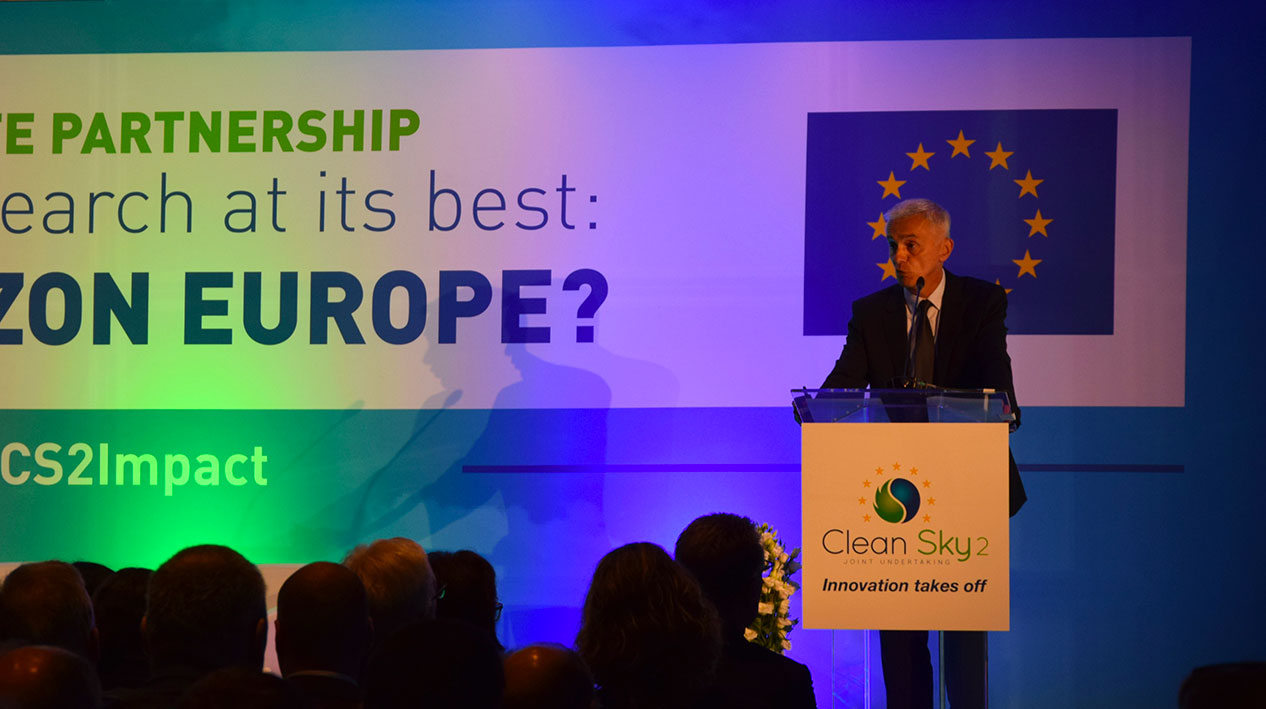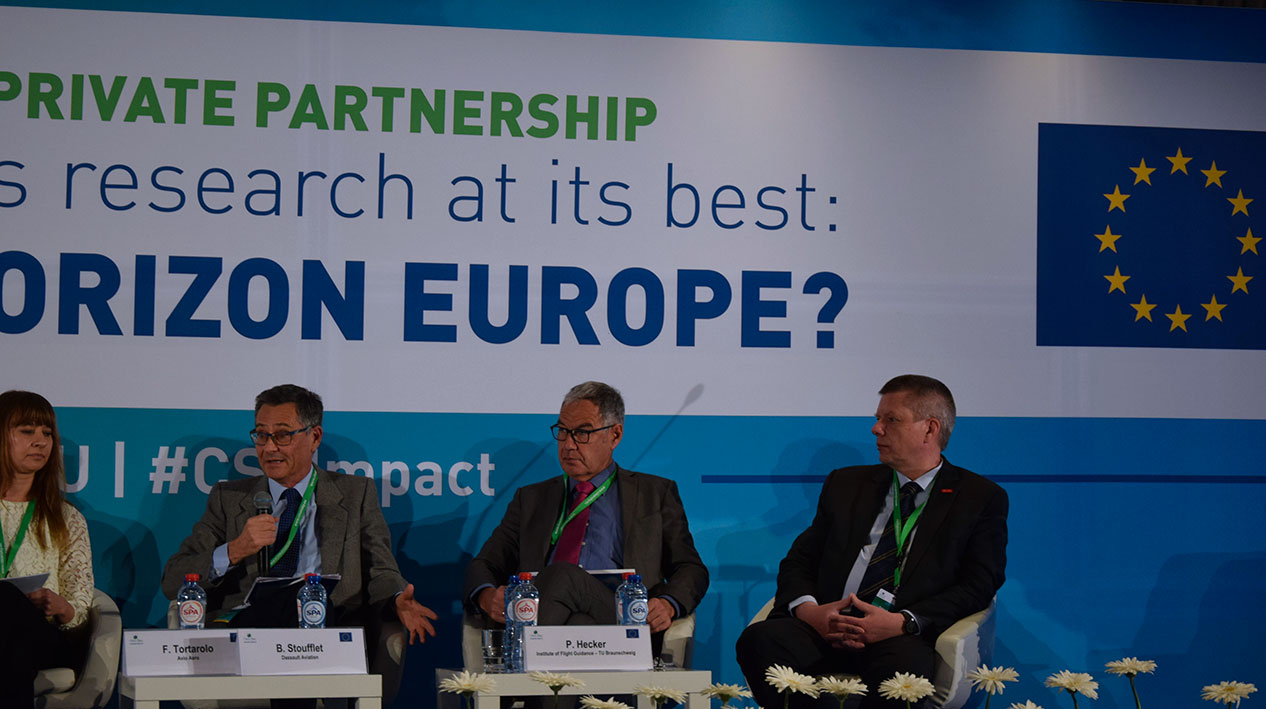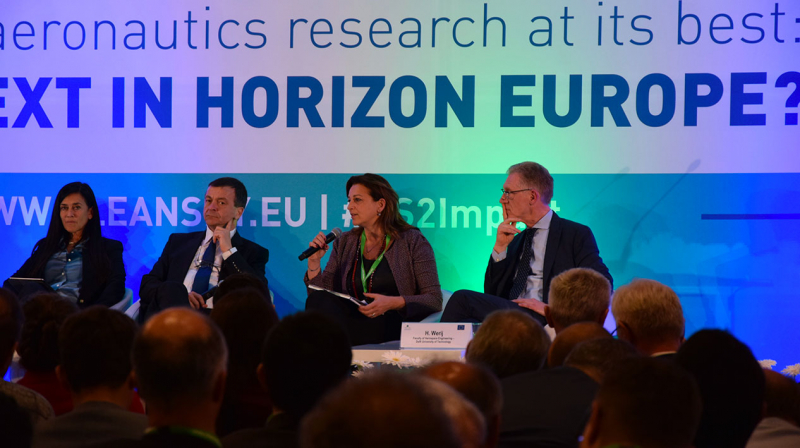Future
The sky above Europe
The Clean Sky2 conference looks at the upcoming challenges, at aeronautical innovations which enable sustainable development and a future with lower environmental impact.
Apr 2019
Although Brexit may worry the most passionate Europeanists, the borders of the so-called “old continent” (at least the airport ones) are more and more crossed by travelers. The numbers say so, and not only those relating to the growth of the total number of flights in Europe – over 9.5 million in 2017, +8% since 2014 – but also the EASA estimates (European Aviation Safety Agency) forecast a +42% if you look at the year 2040.
Therefore, European citizens fly, and quite a lot, but they pay more attention to their “carbon footprint”, that is the per capita impact of CO2 emissions on the environment, but also those of NOx and noise, produced by their air travel. This is well known to Clean Sky 2 Joint Undertaking, Europe's largest aeronautical research programme, which focuses on the environmentally sustainable progress of the aviation industry and its products.
Clean Sky 2 JU, the public-private partnership formed by the European Commission together with the main leading continental companies in the sector (Airbus, Safran, Dassault Aviation, Leonardo and Rolls Royce, to name a few) was initiated in 2008 under the Framework programme 7 (which ended in 2017) and continued under Horizon 2020, guaranteeing aeronautical research and technological development a budget of 1.6 billion euros spread over seven years.

Clean Sky 2 (which started in 2014 and will end in 2024) hosted its conference in Brussels on 9 and 10 April to share technological advances, results and prospects for the next editions of the programme within the wider European research platform Horizon 2020. The event was attended by representatives from major industrial leaders along with those of core partners (including Avio Aero along with several GE Aviation teams based in Europe) and many partners. In total the Clean Sky 2 Programme accounts for the participation of around 420 small and medium enterprises, over 373 specialized research centers and 350 of the most renowned universities from 28 countries.
This group of scientists, technicians, engineers and manufacturers has for years been studying and even implementing or applying unique and innovative technological solutions entirely aimed at gradual decarbonisation. In fact, by 2050, 75% of the commercial fleets currently in service in the world will be replaced by aircrafts that will enter the market between 2025 and 2035, capable of enabling a potential reduction of 4 billion tons of CO2 by 2050 thanks to the implementation of Clean Sky 2 technologies.
The span of influence is very wide: since Clean Sky 2 the projects have also expanded to the small air transport sector, and therefore all future urban mobility solutions, whether electric or hybrid propulsion. But Clean Sky 2's new technologies range from the design of wing and fuselage structures that use revolutionary materials and shapes to lighten, improve performance and reduce fuel consumption (and therefore emissions), to long-range aircraft with new engine architectures and cutting-edge digital instrumentation. Innovations in aerodynamics, aeroacoustics, regional and high-speed transport, but also in manufacturing processes (i.e. additive, in which Avio Aero is at the forefront, is a shining example) and for the recycling of materials, to limit the pollution produced even in airports.
"We have currently reached 50% of achievement of the many projects in progress: the 2/3 completion is expected by the end of year, thanks to over 5,000 engineers and scientists"
“Our guiding light is -80% greenhouse gas emissions, and therefore the reduction of the global temperature by 1.5 or 2 degrees,” says Axel Krein, Executive Director of Clean Sky 2 JU. These objectives stem from the Paris Climate Conference and the UN Agenda 2030, which also includes the 17 Sustainable Development Goals (SDGs) where the aviation sector has a key role to play in 15 goals.. “In Clean Sky 2 we have currently reached 50% of achievement of the many projects in progress, and we will reach the 2/3 completion by the end of the year thanks to the over 5,000 engineers and scientists working on our projects,” he added.
Krein does not stop at the list of work done and results expected in the coming months, but is already looking ahead to the continuation of the programme and the work that awaits him together with the European Commission to understand which processes and procedures to follow in order to continue along the path of the sustainable future for aviation. “I think the next challenge will be to synchronize the programme’s ambitions with the available budget”, he concludes.
The same perspective is reiterated by Ron Van Manen, Programme Manager of the Clean Sky 2 Joint Undertaking, who says: “I would already be available and willing to work on the planning of Clean Sky 3 and even Clean Sky 4... ours is a battle against climate change, it is a generational mission: what world do we want to leave to our grandchildren. There is no planet B, only our planet we live in.”
"Our battle is against climate change, it's a generational mission: what world do we want to leave to our grandchildren. There is no planet B, only our planet we live in"
Van Manen focuses on the new generation of greener aeronautical products that move towards solutions entailing absolute integration between engine and aircraft, what in engineering jargon is called “distributed propulsion”, or more propulsion systems (that are more environmentally friendly) for a single aircraft. “If we think of some of the many projects that Avio Aero follows in Clean Sky, these move exactly in that direction, they are all very stimulating and important precisely because they go in the direction of integration and large-scale demonstration.”
Van Manen's reference is clearly referring to the example of the Racer, the Airbus Helicopters demonstrator, that has already enthralled everyone with its avant-garde profile and will fly within a year with the transmission system designed and built by Avio Aero, and is also equipped with other GE Aviation technologies. “The network of GE Aviation in Europe (made up of engineering centers, plants and university collaborations) joined with Avio Aero - that has been active in these challenges for the industry’s global sustainability since the birth of Clean Sky - is a further asset for the platform.”
Lastly, institutional advocacy is a founding element of the Clean Sky 2 Joint Undertaking, as evidenced by the speeches given during the conference by Members of the European Parliament, Commission representatives, national ministers, but also by local institutional figures. For Italy, at the conference spoke Valeria Fascione, Regional Minister for Innovation, Internationalization and Start-up of the Campania Region. She also signed an MoU for the region which is “very useful and functional in order to promote opportunities for SMEs in Campania as well as the presence of Clean Sky on the territory in defining technological strategies.”
Valeria Fascione is obviously familiar with the Avio Aero production plant in Pomigliano. “The presence of large companies and important players in our Campania region is a tremendous help for the small and medium enterprises,” she explains, “and these enterprises that produce the driving effect for development. The game must therefore be played on a global level, starting with the local level, so that the global players facilitate expansion, overcoming regional boundaries: if large companies find skills, opportunities and incitement on the territory, at the same time SMEs will have a more direct relationship with the large company, or rather a market opportunity as well as qualification.” The Regional Minister’s reference is to industry 4.0 and digitization, Avio Aero’s distinctive capacities and, likewise, growth chances for the related industries that gravitate around it.
"The game of development must be played on a global level, starting from the local level, so that the global players facilitate expansion, overcoming regional boundaries"










